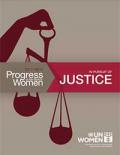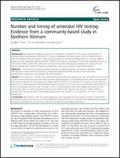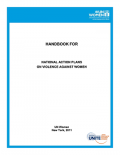What's New
Displaying results 3751 - 3760 of 4914

Resource | Guidelines,
As part of scaling up HIV prevention, treatment, care and support services within the context of universal access, countries need up-to-date and robust strategic information. This information is required to monitor and evaluate the effectiveness, efficiency, equity and acceptability of the HIV services. Information on the efficiency of HIV services requires up-to-date and robust information on the cost and cost–effectiveness of these services. The way to obtain information on cost is to perform a costing study.
The aim of this manual is to provide a simple guide on the process of gathering data to calculate the cost of HIV services provided at health facilities.

Resource | Publications,
This volume of Progress of the World's Women starts with a paradox: the past century has seen a transformation in women's legal rights, with countries in every region expanding the scope of women's legal entitlements. Nevertheless, for most of the world’s women the laws that exist on paper do not always translate into equality and justice. In many contexts, in rich and poor countries alike, the infrastructure of justice – the police, the courts and the judiciary – is failing women, which manifests itself in poor services and hostile attitudes from the very people whose duty it is to fulfil women’s rights. As a result, although equality between women and men is guaranteed in the constitutions of 139 countries and territories, inadequate laws and loopholes in legislative frameworks, poor enforcement and vast implementation gaps make these guarantees hollow promises, having little impact on the day-to-day lives of women.
To date, 186 Member States worldwide have ratified the Convention on the Elimination of All Forms of Discrimination against Women (CEDAW), which entered into force in 1981, signaling their commitment to fulfilling the human rights of women and girls and breaking down the barriers to achieving gender equality and justice.

Resource | Publications,
This Global Plan provides the foundation for country-led movement towards the elimination of new HIV infections among children and keeping their mothers alive.
It is possible to stop new HIV infections among children and keep their mothers alive if pregnant women living with HIV and their children have timely access to quality life-saving antiretroviral drugs—for their own health, as indicated, or as a prophylaxis to stop HIV transmission during pregnancy, delivery and breastfeeding. When antiretroviral drugs are available as prophylaxis, HIV transmission can be reduced to less than 5%. Preventing HIV infection among women at increased risk of HIV and meeting unmet family planning needs of women living with HIV can significantly contribute to reducing the need for antiretroviral prophylaxis and treatment.
There is global consensus that the world must strive towards elimination of new HIV infections among children by 2015 and keep mothers and children living with HIV alive. Many low-and middle-income countries have already moved significantly towards achieving these goals.

Resource | Publications,
HIV (Human immunodeficiency virus) transmission has been reduced by protected sex and screening of blood products and other body fluids in the developed countries. It has been reported that Pakistan is at high risk of HIV/AIDS infection but presently the prevalence rate is considerably low. The number of reported cases of HIV/AIDS in Pakistan has been continuously increasing since 1987. By 2010 the total number of registered cases has reached to 6000 and this figure is on the rise with the passage of time. Some serious strategies must be implemented to control this deadly disease.

Resource | Publications,
HIV testing for pregnant women is an important component for the success of prevention of mother-to-child transmission of HIV (PMTCT). A lack of antenatal HIV testing results in loss of benefits for HIV-infected mothers and their children. However, the provision of unnecessary repeat tests at a very late stage of pregnancy will reduce the beneficial effects of PMTCT and impose unnecessary costs for the individual woman as well as the health system. This study aims to assess the number and timing of antenatal HIV testing in a low-income setting where PMTCT programmes have been scaled up to reach first level health facilities.
A cross-sectional community-based study was conducted among 1108 recently delivered mothers through face-to-face interviews following a structured questionnaire that focused on socio-economic characteristics, experiences of antenatal care and HIV testing.

Resource | Publications,
HIV infection was first detected in Sri Lanka in 1987 and it will continue to be with us for many decades to come. The estimated number of people living with HIV as at the end of 2007 is around 3500-4000. Hence, Sri Lanka is considered a country with a low prevalence of HIV infection. However, a gradual increase in new cases is being observed and the feminization of the epidemic is emerging. The presence of certain socio-demographic and behavioural factors may change the present HIV landscape.
Based on the above factors and the recommendations of the external review carried out to assess the national response against HIV during the five year period ended in 2006, a new strategic plan for 2007 – 2011 was formulated. This was completed with a wider participation of stakeholders from government, non-governmental organizations, business community, religious leaders and people living with HIV. This plan has identified main strategies based on a set of principles and has identified programme priorities, and areas in which various sectors need to focus future actions. Monitoring and evaluation will be based on the indicator frame work.

Resource | Publications,
This report reviews progress made until the end of 2010 in scaling up access to health sector interventions for HIV prevention, treatment, care, and support in low–and middle-income countries. It is the fifth in a series of annual progress reports published since 2006 by the World Health Organization (WHO), United Nations Children’s Fund (UNICEF), and Joint United Nations Programme on HIV/ AIDS (UNAIDS), in collaboration with national and international partners, to monitor key components of the health sector response to the HIV epidemic.

Resource | Publications,
The recent HIV estimations highlight an overall reduction in adult HIV prevalence as well as new infections (HIV incidence) in the country, although variations exist across the states. The analysis of epidemic projections has revealed that the number of annual new HIV infections has declined by more than 50 percent during the last decade.

Resource | Publications,
This Handbook is based on the results of an expert group meeting on good practices in national action plans on violence against women. The meeting was convened by the United Nations Entity for Gender Equality and Empowerment of Women, UN-Women, in cooperation with the United Nations Economic Commission for Latin America and the Caribbean Subregional Headquarters for the Caribbean, Port-of-Spain, Trinidad and Tobago, in September 2010.

Resource | Publications,
Currently Sri Lanka is experiencing a low level HIV epidemic. The estimated number of people living with HIV as at end 2009 was 3000 and the estimated HIV prevalence among adults (15-49 years) is less than 0.1%. Survey data observes that even among individuals considered at higher risk of infection on the basis of their occupation, behaviors and practices, the HIV prevalence is below 1%. As at end December 2011, a cumulative total of 1463 HIV persons were reported to the NSACP. The main mode of transmission is due to unprotected sex between men and women (82.8%)





